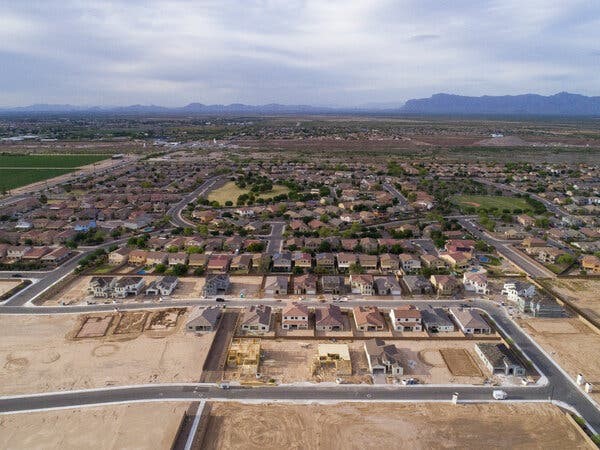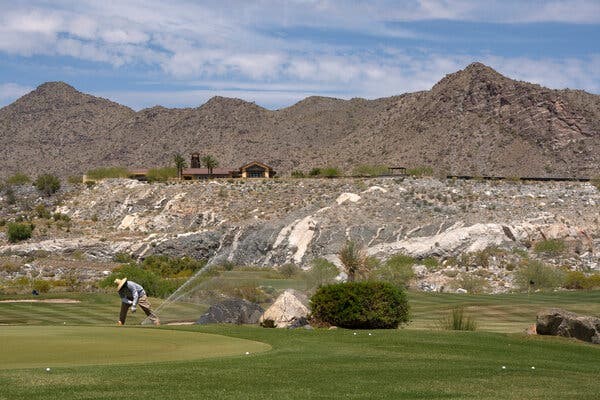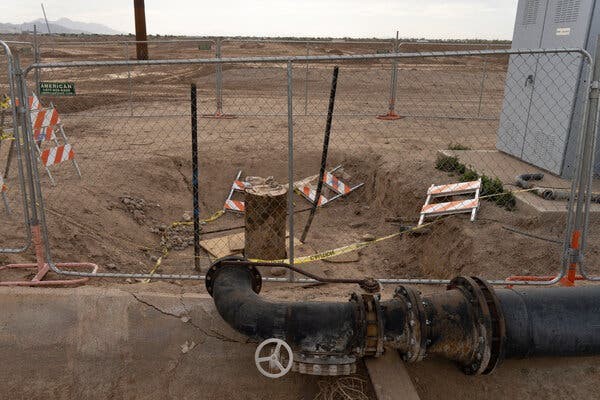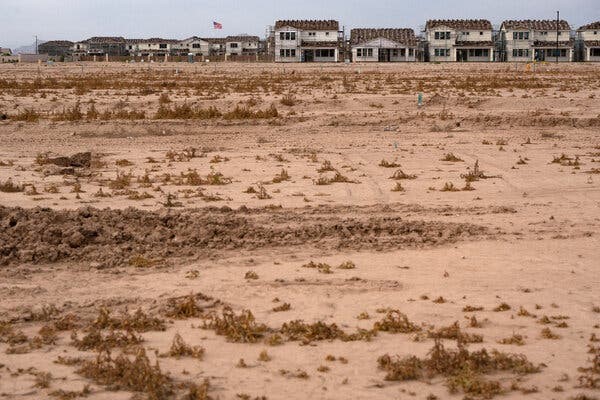n what could be a glimpse of the future as climate change batters the West, officials ruled there’s not enough groundwater for projects already approved.
https://www.nytimes.com/2023/06/01/climate/arizona-phoenix-permits-housing-water.html

Queen Creek, Ariz., a suburb of Phoenix, is projected to grow to 175,000 people from its current 75,000 — if it can find enough water. Credit: Rebecca Noble for The New York Times
By Christopher Flavelle and Jack Healy
Christopher Flavelle reported from Washington and Jack Healy from Phoenix.
Climate Forward There’s an ongoing crisis — and tons of news. Our newsletter keeps you up to date. Get it in your inbox.
Arizona has determined that there is not enough groundwater for all of the housing construction that has already been approved in the Phoenix area, and will stop developers from building some new subdivisions, a sign of looming trouble in the West and other places where overuse, drought and climate change are straining water supplies.
The decision by state officials very likely means the beginning of the end to the explosive development that has made the Phoenix area the fastest growing metropolitan region in the country.
The state said it would not revoke building permits that have already been issued and is instead counting on new water conservation measures and alternative sources to produce the water necessary for housing developments that have already been approved.
On Thursday, Governor Katie Hobbs, a Democrat, said Arizona was not immediately running dry and that new construction would continue in major cities like Phoenix. The analysis prepared by the state looked at groundwater levels over the next 100 years.
“We’re going to manage this situation,” she said at a news conference. “We are not out of water and we will not be running out of water.”
Maricopa County, which includes Phoenix and its suburbs, gets more than half its water supply from groundwater. Most of the rest comes from rivers and aqueducts as well as recycled wastewater. In practical terms, groundwater is a finite resource; it can take thousands of years or longer to be replenished.
The announcement of a groundwater shortage means Arizona would no longer give developers in some areas of Maricopa County new permits to construct homes that rely on wells for water.
Phoenix and nearby large cities, which must obtain separate permission from state officials for their development plans every 10 to 15 years, would also be denied approval for any homes that rely on groundwater beyond what the state has already authorized.
The decision means cities and developers must look for alternative sources of water to support future development — for example, by trying to buy access to river water from farmers or Native American tribes, many of whom are facing their own shortages. That rush to buy water is likely to rattle the real estate market in Arizona, making homes more expensive and threatening the relatively low housing costs that had made the region a magnet for people from across the country.
“Housing affordability will be a challenge moving forward,” said Spencer Kamps, vice president of legislative affairs for the Home Builders Association of Central Arizona, an industry group. He noted that even as the state limits home construction, commercial buildings, factories and other kinds of development can continue.
Water Shortages in the United States
- Halting Construction: Officials ruled that there is not enough groundwater for all of the already approved housing projects in the Phoenix area, a sign of looming trouble in places where overuse, drought and climate change are straining water supplies.
- Cut Off: As hundreds of homes outside the boundaries of Scottsdale, Ariz., can no longer get water from the city, their owners are living a worst-case scenario of drought.
- A Test for Developers: In the increasingly dry Southwest, developers are facing the intensifying challenge of building huge residential projects in an era of water scarcity.
Even so, the change will act as a signal to developers, said Sarah Porter, director of the Kyl Center for Water Policy at Arizona State University. “We see the horizon for the end of sprawl,” she said.

Victory Course at Verrado in Buckeye, Ariz Credit…Rebecca Noble for The New York Times
A groundwater shortage would likely not derail the planned growth in the short term in major cities like Phoenix, Scottsdale and Mesa, Ms. Porter said.
“There is still capacity for development within designated cities,” Ms. Porter said, referring to cities whose growth plans had already been approved by state water officials. Those cities would not be able to get approval to build any homes that rely on groundwater beyond that amount.
The new restrictions would be felt hardest and most immediately in small towns and unincorporated swaths of desert along the fringes of the Phoenix metro area — where most lower-cost homes tend to get built. “Those have been hot spots for growth,” Ms. Porter said.
Climate Forward There’s an ongoing crisis — and tons of news. Our newsletter keeps you up to date. Get it in your inbox.
The announcement is the latest example of how climate change is reshaping the American Southwest. A 23-year drought and rising temperatures have lowered the level of the Colorado River, threatening the 40 million Americans in Arizona and six other states who rely on it — including residents of Phoenix, which gets water from the Colorado by aqueduct.
Rising temperatures have increased the rate of evaporation from the river, even as crops require more water to survive those higher temperatures. The water that Arizona receives from the Colorado River has already been cut significantly through a voluntary agreement among the seven states. Last month, Arizona agreed to conservation measures that would further reduce its supply.
The result is that Arizona’s water supply is being squeezed from both directions: disappearing ground water as well as the shrinking Colorado River.
And the water shortage could be more severe than the state’s analysis shows because it assumes that Arizona’s supply from the Colorado would remain constant over the next 100 years, something that is uncertain at best.
The Phoenix area occupies a valley in southern Arizona, cradled by mountain ridges and sliced by the Salt and Gila rivers. The landscape is filled with lush golf courses, baseball diamonds, farm fields and swimming pools, contrasted against rocky brown terrain that surrounds it.
The county uses some 2.2 billion gallons of water a day — more than twice as much as New York City, despite having half as many people.
Arizona’s water problems have begun to percolate through the state’s politics. When she took office in January, Governor Hobbs pledged in her first major address to tighten controls on groundwater use around the state.
As evidence of that commitment, Governor Hobbs released a report that she said had been suppressed by the previous administration, which was Republican-led. It showed that an area west of Phoenix, called the Hassayampa sub-basin, doesn’t have enough water for new wells. As a result, the Arizona Department of Water Resources said it would no longer issue new permits in that region for the construction of homes that would rely on groundwater.

A well site in Queen Creek, one of the fastest growing places in Arizona. Credit…Rebecca Noble for The New York Times
But Hassayampa is just one of several sub-basins that make up the larger groundwater basin underneath metropolitan Phoenix. The state’s announcement on Thursday essentially extends that finding across the Phoenix area.
One of the places very likely to feel the impact of the new restrictions is Queen Creek.
When Arizona created its groundwater rules more than 40 years ago, Queen Creek was still mostly peach and citrus groves and expansive farmland. Today, it is one of the fastest-growing places in Arizona, where families go fishing at an “oasis” lake fed by recycled wastewater. The town’s population of 75,000 is projected to grow to 175,000 by the time it is built out decades from now.
But to do any of that, the town needs to find more water.
“We’re in search of about 30,000 acre feet,” or about 9.8 billion gallons per year, said Paul Gardner, Queen Creek’s utility director.
Since there isn’t enough groundwater to supply its needs for future growth, Queen Creek is hunting for water anywhere it can, exploring proposals such as transferring it via canal from western Arizona, expanding the Bartlett Lake reservoir by joining other cities in a project to build a higher dam.
Unlike Phoenix, Queen Creek doesn’t have a “designation” from the state — essentially, a determination that the city has enough water to support new homes. Without that designation, each proposed development must prove to the state it has a 100-year supply. Developers without that seal of approval would now have to find sources other than groundwater.

Stalled construction on a lot in Queen Creek. Credit…Rebecca Noble for The New York Times
Even as the state takes steps to try to slow depletion, the Kyl Center has warned that Arizona is still pumping too much groundwater. New industrial projects are sucking up groundwater without restrictions, and demand for water is outpacing any gains from conservation efforts, the center found in a 2021 report.
Despite the increasingly dire warnings from the state and water experts, some developers note that construction will not stop anytime soon. The Arizona water agency has given permission for construction on about 80,000 housing lots that have yet to be built, a state official said.
Cynthia Campbell, Phoenix’s water-resources management adviser, said the city largely relies on river water, and groundwater represents only about 2 percent of its water supply. But that could change drastically if Arizona were hit with drastic cuts in its Colorado River allotments, forcing the city to pump more groundwater.
Many outlying developments and towns in Maricopa County’s sprawl have been able to build by enrolling in a state-authorized program that lets subdivisions suck up groundwater in one place if they pump it back into the ground elsewhere in the basin.
Ms. Campbell said the idea that you could balance water supplies like that had always been a “legal fiction,” one that now appears to be unraveling as the state takes a harder look at where the groundwater supplies are coming up short.
“This is the hydrologic disconnect coming home to roost,” Ms. Campbell said.
In outlying areas, “a lot of the developers are really worried, they’re freaked,” Ms. Campbell said. “The reality is, it all came back to catch us.”
Have Climate Questions? Get Answers Here.
Christopher Flavelle is a Washington-based climate reporter for The Times, focusing on how people, governments and industries try to cope with the effects of global warming. @cflav
Jack Healy is a Phoenix-based national correspondent who focuses on the fast-changing politics and climate of the Southwest. He has worked in Iraq and Afghanistan and is a graduate of the University of Missouri’s journalism school. @jackhealynyt • Facebook
A version of this article appears in print on June 2, 2023, Section A, Page 1 of the New York edition with the headline: Eye on Water, Arizona Caps New Housing. Order Reprints | Today’s Paper | Subscribe

